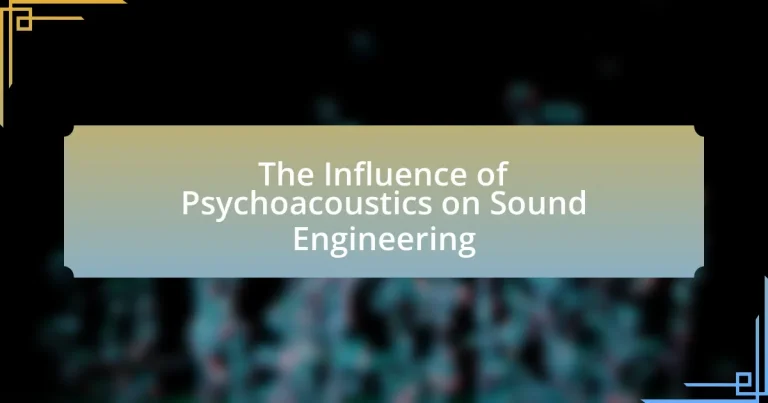The article examines the significant influence of psychoacoustics on sound engineering, highlighting how the study of human auditory perception shapes sound design, mixing, and mastering techniques. Key principles such as auditory masking, frequency sensitivity, and the Fletcher-Munson curves are discussed, illustrating their impact on audio quality and listener experience. The article also addresses the challenges sound engineers face when integrating psychoacoustic concepts, including individual variability in hearing and technological constraints. Furthermore, it explores emerging trends and innovations in the field, emphasizing the importance of psychoacoustics in creating immersive and effective audio experiences.

What is the Influence of Psychoacoustics on Sound Engineering?
Psychoacoustics significantly influences sound engineering by shaping how sound is perceived and processed. This field studies the psychological and physiological responses to sound, which informs sound design, mixing, and mastering techniques. For instance, understanding the Fletcher-Munson curves, which illustrate human sensitivity to different frequencies at varying loudness levels, allows sound engineers to create mixes that sound balanced across various playback systems. Additionally, psychoacoustic principles guide the development of audio compression algorithms, ensuring that sound quality is maintained while reducing file sizes. This integration of psychoacoustics into sound engineering practices enhances the overall listening experience, making it a critical component in the industry.
How does psychoacoustics impact sound perception?
Psychoacoustics significantly impacts sound perception by studying how humans interpret and respond to sound stimuli. This field reveals that factors such as frequency, amplitude, and temporal patterns influence auditory experiences, leading to variations in how sounds are perceived. For instance, research indicates that humans are more sensitive to certain frequencies, particularly in the range of 2,000 to 5,000 Hz, which corresponds to the frequencies of human speech. This sensitivity affects how sounds are mixed and mastered in sound engineering, ensuring clarity and intelligibility in audio production. Additionally, psychoacoustic principles inform the design of audio equipment and environments, optimizing sound quality based on human auditory perception.
What are the key principles of psychoacoustics?
The key principles of psychoacoustics include the perception of sound, auditory masking, and the relationship between sound frequency and loudness. Psychoacoustics studies how humans perceive sound, emphasizing that sound perception is not solely based on physical properties but also on psychological factors. Auditory masking occurs when a louder sound makes it difficult to hear a softer sound, demonstrating the interaction between different sound frequencies. Additionally, the relationship between sound frequency and loudness is characterized by the Fletcher-Munson curves, which illustrate that human sensitivity to sound varies across different frequencies, influencing sound engineering practices. These principles are foundational in designing audio systems and optimizing sound quality in various applications.
How do these principles relate to sound engineering practices?
Psychoacoustic principles directly inform sound engineering practices by guiding how sound is perceived and manipulated. These principles, such as masking effects and critical bands, help sound engineers optimize audio quality and create immersive listening experiences. For instance, understanding that certain frequencies can mask others allows engineers to make informed decisions about equalization and mixing, ensuring clarity in the final product. Research has shown that applying psychoacoustic theories can enhance listener satisfaction and engagement, as evidenced by studies demonstrating improved audio perception when these principles are utilized in sound design.
Why is psychoacoustics important in sound design?
Psychoacoustics is important in sound design because it studies how humans perceive sound, which directly influences the effectiveness of audio in various applications. Understanding psychoacoustic principles allows sound designers to create audio experiences that resonate emotionally with listeners, enhance immersion, and optimize sound quality. For instance, research shows that certain frequencies can evoke specific emotional responses, and sound designers can leverage this knowledge to craft soundscapes that align with the intended mood of a project. Additionally, psychoacoustics informs techniques such as masking, where louder sounds can obscure quieter ones, enabling designers to prioritize essential audio elements in a mix.
What role does psychoacoustics play in audio quality?
Psychoacoustics significantly influences audio quality by examining how humans perceive sound, which directly affects the design and engineering of audio systems. This field studies auditory perception, including how frequency, amplitude, and temporal aspects of sound are interpreted by the human brain. For instance, research indicates that certain frequencies are more easily perceived than others, leading sound engineers to prioritize these frequencies in audio production to enhance listener experience. Additionally, psychoacoustic principles guide the development of audio compression algorithms, such as MP3, which exploit human hearing limitations to reduce file sizes without a noticeable loss in perceived quality. This demonstrates that understanding psychoacoustics is essential for optimizing audio quality in various applications, from music production to telecommunications.
How can psychoacoustics enhance listener experience?
Psychoacoustics enhances listener experience by understanding how humans perceive sound, allowing sound engineers to create audio that resonates emotionally and cognitively with audiences. By applying principles of psychoacoustics, such as frequency masking and spatial perception, sound engineers can optimize audio quality, making it more immersive and engaging. For instance, research shows that utilizing specific frequency ranges can evoke emotional responses, as demonstrated in studies like “The Emotional Impact of Music: A Psychoacoustic Perspective” by Brattico et al. (2013), which highlights how sound design influences listener emotions and overall experience.

How do sound engineers apply psychoacoustic principles?
Sound engineers apply psychoacoustic principles by utilizing knowledge of human auditory perception to enhance audio quality and listener experience. They manipulate sound characteristics such as frequency, amplitude, and timing to create effects that align with how humans perceive sound, ensuring clarity and emotional impact. For instance, engineers often use equalization to adjust frequencies that are more sensitive to human hearing, typically between 1 kHz and 4 kHz, which can significantly improve vocal intelligibility. Additionally, they employ techniques like dynamic range compression to manage loudness perception, making quieter sounds more audible without distorting louder sounds. This application of psychoacoustic principles is supported by research indicating that sound perception is not solely based on physical sound properties but also on cognitive and contextual factors, thereby validating the effectiveness of these techniques in sound engineering.
What techniques do sound engineers use based on psychoacoustics?
Sound engineers utilize various techniques based on psychoacoustics to enhance audio perception and quality. These techniques include equalization, which adjusts frequency balance to align with human hearing sensitivity; dynamic range compression, which controls volume fluctuations to maintain consistent loudness; and spatial audio processing, which creates a sense of directionality and space in sound. Research indicates that equalization can significantly improve listener satisfaction by compensating for the ear’s frequency response, while dynamic range compression is widely used in broadcasting to ensure clarity and intelligibility. Additionally, spatial audio techniques, such as binaural recording, exploit the way humans localize sound, enhancing the immersive experience.
How does equalization utilize psychoacoustic concepts?
Equalization utilizes psychoacoustic concepts by adjusting frequency levels to align with human auditory perception, enhancing the listening experience. Psychoacoustics reveals that humans perceive sound differently across various frequencies; for instance, the Fletcher-Munson curves illustrate that our ears are more sensitive to mid-range frequencies than to very low or high frequencies. By applying equalization, sound engineers can boost or cut specific frequencies to compensate for these perceptual biases, ensuring that music or audio content sounds balanced and clear to listeners. This application of psychoacoustic principles allows for more effective sound design and mixing, ultimately leading to a more enjoyable auditory experience.
What is the significance of spatial audio in psychoacoustics?
Spatial audio is significant in psychoacoustics because it enhances the perception of sound location and environment, allowing listeners to experience a more immersive auditory experience. This technology utilizes techniques such as binaural recording and surround sound to create a three-dimensional sound field, which aligns with how humans naturally perceive sound direction and distance. Research indicates that spatial audio can improve listener engagement and emotional response, as demonstrated in studies showing that immersive audio environments can lead to heightened emotional reactions and better memory retention of auditory information.
How do psychoacoustic models influence audio processing?
Psychoacoustic models significantly influence audio processing by simulating human auditory perception to optimize sound quality and compression. These models analyze how humans perceive sound, including aspects like loudness, pitch, and masking effects, allowing engineers to prioritize audio elements that are most important to listeners. For instance, the MP3 compression algorithm utilizes psychoacoustic principles to remove inaudible frequencies, resulting in smaller file sizes without a noticeable loss in quality. Research by Brandenburg and Bosi in “ISO/IEC 11172-3: Audio Compression” demonstrates that psychoacoustic models can effectively reduce data rates while maintaining perceived audio fidelity, confirming their critical role in modern audio processing techniques.
What are the common psychoacoustic models used in sound engineering?
Common psychoacoustic models used in sound engineering include the Zwicker model, the Moore-Glasberg model, and the ANSI model. The Zwicker model, developed by Heinz Zwicker, focuses on the perception of loudness and incorporates critical bands, which are frequency ranges that the human ear processes simultaneously. The Moore-Glasberg model, created by Brian Moore and Peter Glasberg, emphasizes the relationship between sound intensity and perceived loudness, providing a more detailed approach to loudness perception. The ANSI model, established by the American National Standards Institute, offers standardized methods for measuring sound levels and loudness, ensuring consistency in sound engineering practices. These models are validated through extensive research in psychoacoustics, demonstrating their effectiveness in predicting human auditory perception.
How do these models affect compression and loudness perception?
Models of psychoacoustics significantly influence compression and loudness perception by providing a framework for understanding how humans perceive sound intensity and frequency. These models, such as the Fletcher-Munson curves, illustrate that perceived loudness is not solely dependent on sound pressure level; rather, it varies with frequency. Consequently, sound engineers utilize these models to apply compression more effectively, ensuring that louder sounds are perceived as balanced across different frequencies. For instance, when compressing audio, engineers can adjust levels based on psychoacoustic principles to maintain perceived loudness, even when dynamic range is reduced. This approach enhances listener experience by preventing distortion and ensuring clarity, particularly in complex audio environments.

What are the challenges of integrating psychoacoustics in sound engineering?
Integrating psychoacoustics in sound engineering presents several challenges, primarily due to the complexity of human auditory perception. One significant challenge is the variability in individual hearing abilities, which can affect how sound is perceived across different listeners. Research indicates that factors such as age, hearing loss, and cultural background can lead to diverse auditory experiences, complicating the design of sound systems that aim for a universal listening experience.
Another challenge is the difficulty in accurately modeling psychoacoustic phenomena, such as masking effects and spatial perception. These phenomena are not easily quantifiable, making it hard for sound engineers to predict how changes in sound design will impact listener experience. Studies, such as those published in the Journal of the Audio Engineering Society, highlight the limitations of existing models in capturing the nuances of human hearing.
Additionally, integrating psychoacoustic principles into technology and software requires a deep understanding of both acoustics and human psychology, which can be a barrier for sound engineers who may not have expertise in both fields. This interdisciplinary gap can hinder the effective application of psychoacoustic research in practical sound engineering scenarios.
What limitations do sound engineers face with psychoacoustic applications?
Sound engineers face several limitations with psychoacoustic applications, primarily due to the subjective nature of human perception. Psychoacoustics relies on how individuals perceive sound, which can vary widely among listeners, making it challenging to create universally accepted audio standards. Additionally, the complexity of modeling auditory perception accurately can lead to difficulties in predicting how sound will be experienced in different environments. Research indicates that factors such as background noise, room acoustics, and individual hearing differences can significantly affect psychoacoustic outcomes, complicating the sound engineering process.
How can subjective listener variability impact psychoacoustic outcomes?
Subjective listener variability can significantly impact psychoacoustic outcomes by influencing how individuals perceive sound characteristics such as loudness, pitch, and timbre. This variability arises from personal factors including age, hearing ability, cultural background, and individual preferences, which can lead to differing interpretations of the same auditory stimulus. For instance, research indicates that younger listeners may perceive higher frequencies more acutely than older listeners, affecting their overall sound experience. Additionally, studies have shown that cultural context can shape preferences for certain musical scales or sound qualities, further diversifying listener responses. Such differences in perception can ultimately affect sound engineering decisions, as engineers must consider these subjective experiences to create audio that resonates with a broader audience.
What technological constraints exist in applying psychoacoustic principles?
Technological constraints in applying psychoacoustic principles include limitations in audio processing capabilities, speaker design, and environmental factors. Audio processing systems may struggle to accurately replicate the complex interactions of sound frequencies that influence human perception, leading to suboptimal sound quality. Additionally, speaker design often fails to account for the nuances of psychoacoustic effects, such as masking and spatial perception, which can result in a less immersive listening experience. Environmental factors, such as room acoustics and background noise, further complicate the application of psychoacoustic principles, as they can distort sound perception and diminish the effectiveness of psychoacoustic techniques. These constraints highlight the challenges faced in integrating psychoacoustic principles into sound engineering effectively.
What future trends are emerging in psychoacoustics and sound engineering?
Emerging trends in psychoacoustics and sound engineering include the integration of artificial intelligence for sound design, advancements in spatial audio technologies, and the development of personalized audio experiences. Artificial intelligence is increasingly being utilized to analyze listener preferences and create adaptive soundscapes, enhancing user engagement. Spatial audio technologies, such as binaural sound and immersive audio formats, are gaining traction, allowing for more realistic sound environments in virtual and augmented reality applications. Additionally, personalized audio experiences are being shaped by machine learning algorithms that tailor sound to individual hearing profiles, improving accessibility and user satisfaction. These trends reflect a shift towards more interactive and customized auditory experiences in the field.
How is technology advancing the understanding of psychoacoustics?
Technology is advancing the understanding of psychoacoustics through enhanced data analysis, simulation tools, and immersive audio experiences. Advanced algorithms and machine learning techniques allow researchers to analyze large datasets of auditory perception, revealing intricate relationships between sound characteristics and human response. For example, tools like MATLAB and Python libraries enable the modeling of auditory phenomena, facilitating the exploration of complex psychoacoustic principles such as masking and spatial perception. Additionally, virtual reality (VR) and augmented reality (AR) technologies provide immersive environments where psychoacoustic theories can be tested in real-time, allowing for a deeper understanding of how sound interacts with human perception in various contexts. These technological advancements contribute to more precise sound engineering practices, ultimately improving audio quality in various applications, from music production to hearing aids.
What innovations are being developed for sound engineering based on psychoacoustics?
Innovations in sound engineering based on psychoacoustics include advanced spatial audio technologies, perceptual coding algorithms, and immersive sound environments. Spatial audio technologies, such as Dolby Atmos and Ambisonics, enhance the listener’s experience by simulating three-dimensional sound fields, which are grounded in psychoacoustic principles of how humans perceive sound directionality and distance. Perceptual coding algorithms, like AAC and MP3, optimize audio compression by leveraging psychoacoustic models that prioritize frequencies most audible to the human ear, thus improving sound quality while reducing file size. Additionally, immersive sound environments are being developed for virtual reality and gaming, utilizing psychoacoustic research to create realistic auditory experiences that mimic real-world sound perception. These innovations demonstrate the practical application of psychoacoustics in enhancing audio quality and user experience in various sound engineering fields.
What best practices should sound engineers follow regarding psychoacoustics?
Sound engineers should prioritize understanding human perception of sound to effectively apply psychoacoustic principles in their work. This includes utilizing techniques such as equalization to enhance perceived clarity and loudness, as well as employing dynamic range compression to manage the perception of loudness without altering the actual sound levels. Additionally, sound engineers should consider the Fletcher-Munson curves, which illustrate how human hearing sensitivity varies with frequency and loudness, guiding them in mixing decisions to ensure balanced sound across different playback systems. By adhering to these practices, sound engineers can create audio that resonates well with listeners, ensuring an optimal auditory experience.





